Yoga mudras are ancient hand gestures that have been used for centuries to balance the body’s energy, improve health, and enhance spiritual growth. These mudras are categorized into several types, including Hasta Mudras, which are specifically formed by the fingers and thumbs. Here are some of the most popular yoga mudras with their names and benefits:
- Yoga Mudras and Their Benefits
- What Are Yoga Mudras?
- Benefits for Yoga Mudras
- Popular Yoga Mudras and Their Benefits
- How to Practice Yoga Mudras
- 10 Yoga Mudras with Names and Their Benefits
- 1. Gyan Mudra (Chin Mudra)
- 2. Shunya Mudra (Mudra of Emptiness)
- 3. Surya Ravi Mudra (Seal of the Sun)
- 4. Lotus Mudra
- Symbolism and Meaning
- Additional Tips
- 5. Anjali Mudra (Namaste or Prayer Position)
- See also: How to Meditation in 7 Simple Steps
- 6. Prana Mudra (Mudra of Life)
- Benefits of Prana Mudra
- 7. Apana Mudra (Downward-Flowing Energy Seal)
- 8. Apana Vayu Mudra (Gesture of Downward Flowing Prana)
- Mental and Emotional Benefits:
- 9 . Varuna Mudra (Seal of Water)
- 10. Dhyana Mudra (Meditation Seal)
- Conclusion
- FAQ
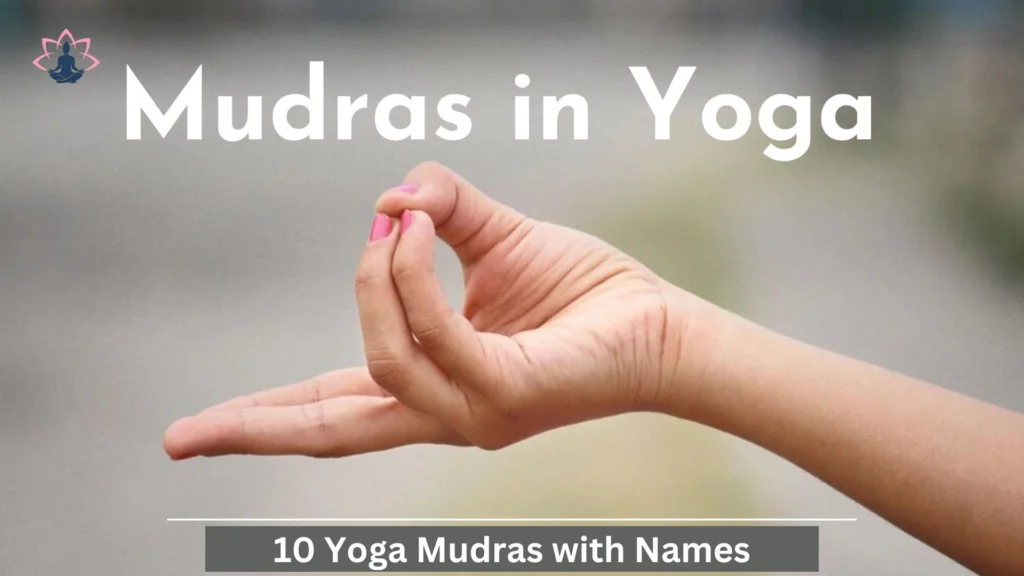
Yoga Mudras and Their Benefits
Yoga mudras are ancient hand gestures used in yoga and meditation practices to channel energy within the body, enhancing physical, mental, and spiritual well-being. These simple yet powerful gestures have been a part of traditional yoga for centuries, offering numerous health benefits and aiding in meditation by promoting focus and relaxation.
What Are Yoga Mudras?
Yoga mudras are symbolic hand postures that influence the flow of energy in the body. Each finger represents an element:
- Thumb: Fire or “Agni”
- Index Finger: Air or “Vayu”
- Middle Finger: Space or “Akash”
- Ring Finger: Earth or “Prithvi”
- Little Finger: Water or “Jal”
By combining these fingers in specific ways, mudras help restore balance and enhance overall health.
Benefits for Yoga Mudras
- Relaxation and Stress Relief: Mudras like Adi Mudra and Prana Mudra help relax the nervous system and reduce stress levels.
- Improved Focus and Concentration: Mudras such as Chin Mudra enhance retention and concentration power.
- Enhanced Physical Health: They improve blood circulation, aid in digestion, and help manage conditions like high blood pressure and arthritis.
- Emotional Balance: Mudras promote emotional well-being by regulating breathing and reducing anxiety.
Popular Yoga Mudras and Their Benefits
| Mudra | Benefits |
|---|---|
| Prana Mudra | Enhances immune system, reduces fatigue, relieves stress. |
| Varun Mudra | Alleviates dehydration, promotes healthy urination, and improves digestion. |
| Surya Mudra | Aids in weight loss by enhancing metabolism. |
| Vayu Mudra | Relieves digestive issues like bloating and constipation. |
| Chin Mudra | Improves sleep patterns and increases energy. |
| Shunya Mudra | Addresses ear-related issues and enhances mental clarity. |
How to Practice Yoga Mudras
- Choose a Mudra: Select a mudra based on your health goals.
- Position Your Hands: Follow the specific finger placement for the chosen mudra.
- Relax and Focus: Practice in a calm environment, focusing on your breath.
Incorporating yoga mudras into your daily routine can lead to profound improvements in both physical and mental health, offering a holistic approach to wellness.
10 Yoga Mudras with Names and Their Benefits
Yoga mudras are ancient hand gestures that help channel and balance the body’s energy. They are an integral part of yoga and meditation practices, offering numerous physical, mental, and spiritual benefits. Here are ten yoga mudras with their names and benefits:
1. Gyan Mudra (Chin Mudra)
Gyan Mudra, also known as Chin Mudra, is a powerful yoga gesture that enhances mental clarity, focus, and spiritual awareness. It is often practiced during meditation to deepen concentration and foster a sense of calm.
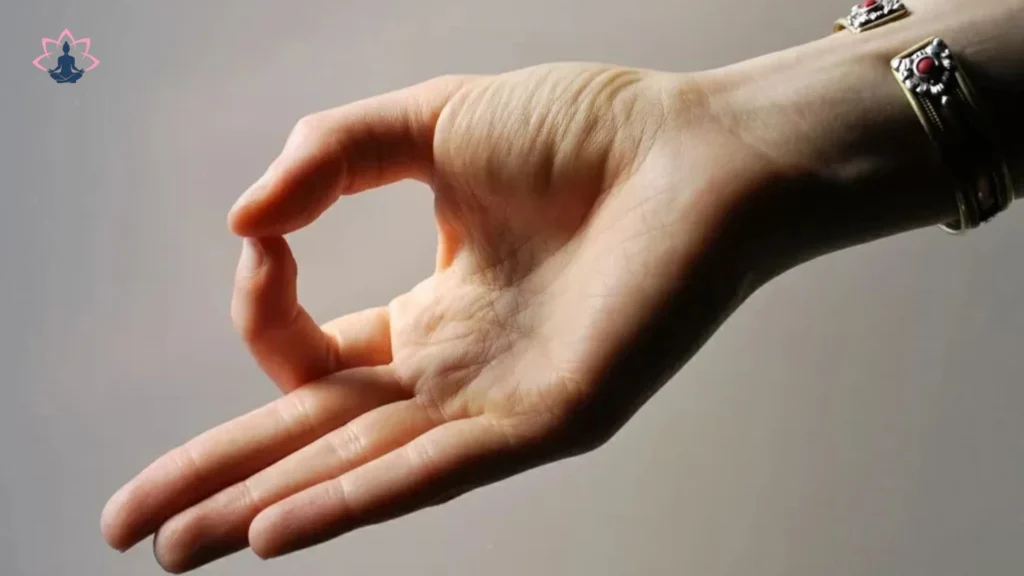
How to Practice Gyan Mudra
- Formation: Sit comfortably with your back straight. Extend your hands with palms facing upwards. Touch the tip of your thumb to the tip of your index finger, keeping the other fingers straight.
- Duration and Frequency: Practice Gyan Mudra for about 15 to 30 minutes daily, ideally during meditation or relaxation.
Benefits of Gyan Mudra
- Mental Clarity and Focus: Enhances concentration, memory, and cognitive abilities, making it beneficial for students and professionals.
- Stress and Anxiety Relief: Creates a calming effect, reducing stress and anxiety by soothing the nervous system.
- Spiritual Growth: Promotes spiritual awareness and self-awareness, helping connect with inner wisdom.
- Chakra Balancing: Heals and activates the root chakra (Muladhara), third eye chakra, and Sahasrara chakra, promoting stability and spiritual growth.
- Hormonal Balance: Stimulates the pituitary gland, improving hormonal balance and reducing symptoms of hormonal imbalances.
Precautions
While generally safe, Gyan Mudra can increase the air element in the body. Individuals with digestive issues should practice it in moderation
2. Shunya Mudra (Mudra of Emptiness)
Shunya Mudra, also known as the “Mudra of Emptiness,” is a powerful hand gesture used in yoga and Ayurveda to promote physical, mental, and spiritual well-being. It is particularly beneficial for auditory health and emotional balance.
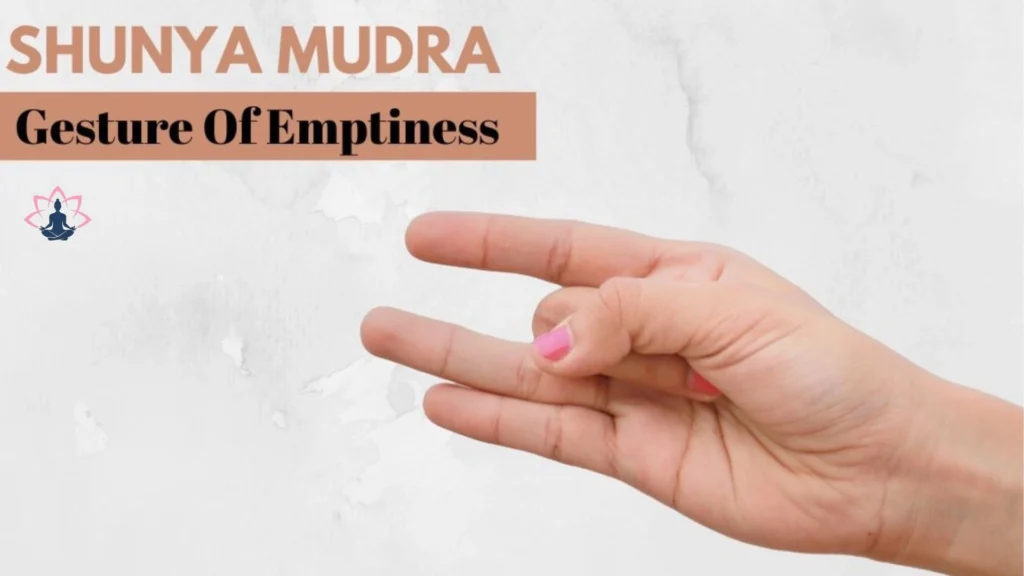
How to Practice Shunya Mudra
- Formation: To practice Shunya Mudra, touch the tip of the middle finger to the base of the thumb. Maintain the other fingers straight and outstretched.
- Duration and Frequency: Practice Shunya Mudra for about 15 to 30 minutes daily, ideally during meditation or relaxation.
Benefits of Shunya Mudra
Physical Benefits:
- Auditory Health: Relieves ear pain, reduces tinnitus, and improves hearing by stimulating energy channels in the ears.
- Thyroid Function: Supports thyroid health by balancing the throat chakra.
- Digestion: Increases metabolism and awakens the digestive fire (Agni), aiding in digestion and nutritional absorption.
- Vertigo and Balance: Helps alleviate vertigo and dizziness by balancing the body’s energy.
Mental and Emotional Benefits:
- Mental Clarity: Enhances concentration and mental clarity, reducing distractions.
- Emotional Release: Encourages emotional openness and release, fostering a sense of calmness.
- Stress Relief: Calms the mind, reducing anxiety and stress.
Spiritual Benefits:
- Connection to Ether: Enhances connection to the element of space, promoting deeper meditation and awareness.
Symbolism and Meaning
Shunya Mudra represents the concept of emptiness or void, symbolizing the release of old patterns and attachments to make way for new growth and transformation.
Additional Tips
- Complementary Practices: Combining Shunya Mudra with other yoga practices or meditation can enhance its benefits.
- Precautions: While generally safe, consult a yoga expert if you have specific health concerns or questions about practicing this mudra.
3. Surya Ravi Mudra (Seal of the Sun)
Surya Ravi Mudra, often referred to in the context of Surya Mudra, is a powerful yoga gesture that embodies the energy of the sun. It is known for its ability to enhance vitality, improve digestion, and boost metabolism. While specific details about “Surya Ravi Mudra” as a distinct mudra are limited, the benefits associated with Surya Mudra can provide insight into its potential effects.
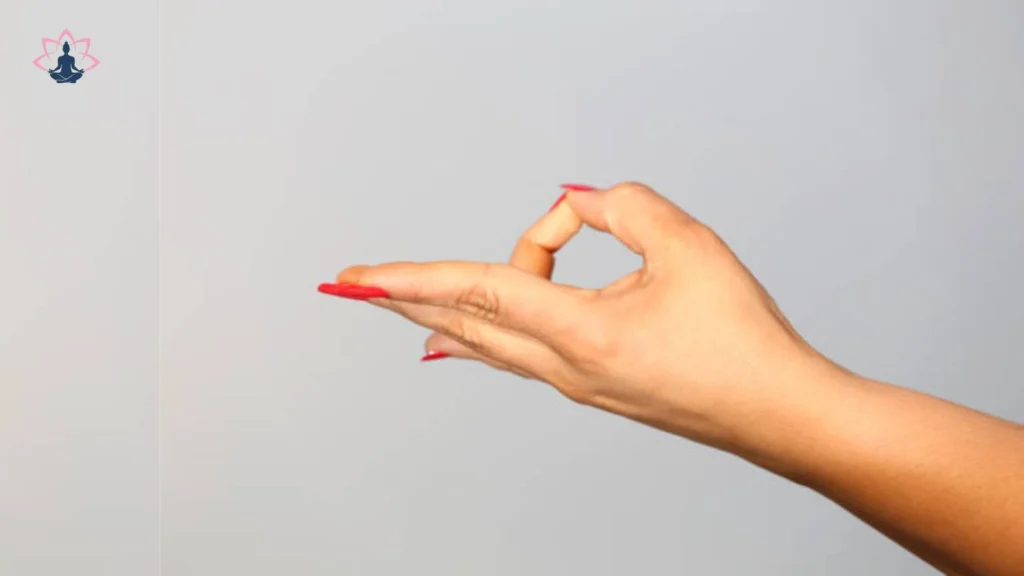
How to Practice Surya Mudra (Similar to Surya Ravi Mudra)
- Formation: To practice Surya Mudra, bend the ring finger to touch the thumb, keeping the other fingers straight.
- Duration and Frequency: Practice Surya Mudra for about 15 to 30 minutes daily, ideally during meditation or relaxation.
Benefits of Surya Mudra
Physical Benefits:
- Weight Loss: Helps reduce weight by increasing metabolism and reducing the earth element in the body.
- Thyroid Function: Stimulates the thyroid gland, improving metabolic functions.
- Digestion: Enhances digestion by boosting the fire element, aiding in conditions like constipation and ulcers.
- Immunity: Increases body heat, which helps fight infections and maintain immunity.
Mental and Emotional Benefits:
- Stress Relief: Reduces stress and depression by increasing body heat and energy.
- Alertness: Keeps the mind sharp and active, promoting focus and mental clarity.
Spiritual Benefits:
- Energy Balance: Balances the body’s energy by increasing the fire element, which can enhance spiritual practices.
Additional Tips
- Complementary Practices: Combining Surya Mudra with other yoga practices or meditation can enhance its benefits.
- Precautions: While generally safe, consult a yoga expert if you have specific health concerns or questions about practicing this mudra.
While “Surya Ravi Mudra” is not extensively documented, the benefits of Surya Mudra offer a comprehensive understanding of how similar practices can positively impact health and well-being.
4. Lotus Mudra
Lotus Mudra, also known as Padma or Pankaja Mudra, is a powerful yoga gesture that embodies the qualities of the lotus flower—purity, resilience, and spiritual growth. It is designed to open the heart center, fostering love, compassion, and inner peace.
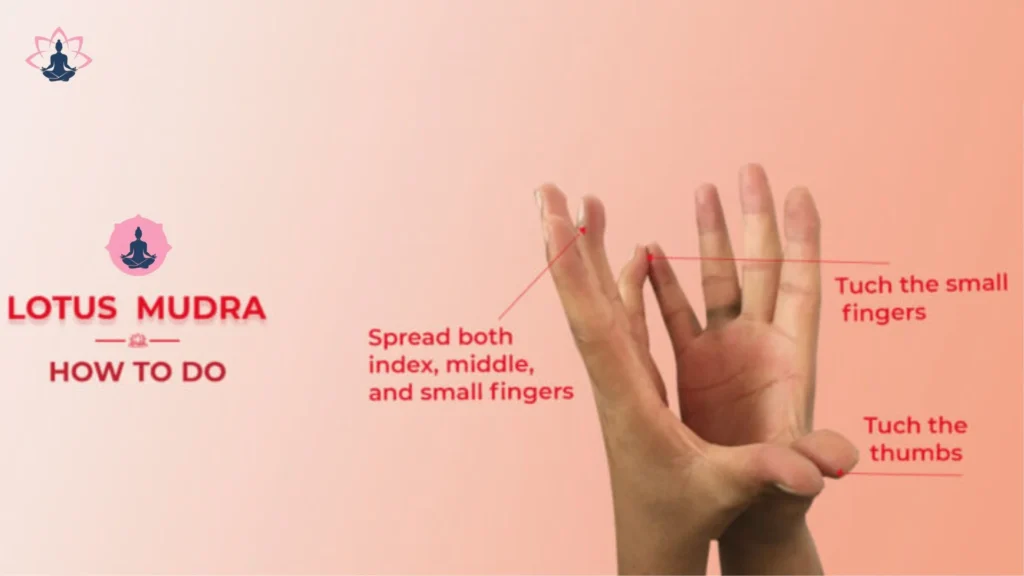
How to Practice Lotus Mudra
- Formation: Sit comfortably with your back straight. Bring your hands together in front of your heart center, with thumbs pointing inward. Touch the palms, thumbs, and fingers together. Then, spread your index, middle, and ring fingers wide like an open lotus flower.
- Duration and Frequency: Practice Lotus Mudra during meditation or yoga sessions, ideally for about 15 to 30 minutes daily.
Benefits of Lotus Mudra
Physical Benefits:
- Relaxation: Relieves tension in the chest and promotes relaxation.
- Circulation: Enhances circulation and improves breath control.
- Digestion: May help with conditions like ulcers and fevers by purifying the body.
Mental and Emotional Benefits:
- Emotional Healing: Encourages feelings of love, compassion, and self-acceptance, aiding in emotional healing.
- Stress Relief: Relieves stress and fatigue, promoting a sense of calmness.
- Mental Clarity: Sharpens focus and calms the mind.
Spiritual Benefits:
- Heart Chakra Activation: Opens the heart chakra (Anahata), fostering spiritual growth, love, and inner light.
- Connection to Nature: Promotes harmony with nature and encourages living in the moment with kindness.
Symbolism and Meaning
The lotus flower symbolizes growth out of darkness into light, representing spiritual awakening and resilience. Practicing Lotus Mudra connects you to these qualities, helping you cultivate inner peace and compassion.
Additional Tips
- Complementary Practices: Combine Lotus Mudra with meditation or specific yoga poses like Padmasana (Lotus Pose) to enhance its benefits.
- Precautions: While generally safe, consult a yoga expert if you have specific health concerns or questions about practicing this mudra.
5. Anjali Mudra (Namaste or Prayer Position)
Anjali Mudra, commonly known as Namaste or Prayer Position, is a revered hand gesture in yoga and Hindu culture. It symbolizes respect, humility, and unity, connecting the individual with their inner self and others.
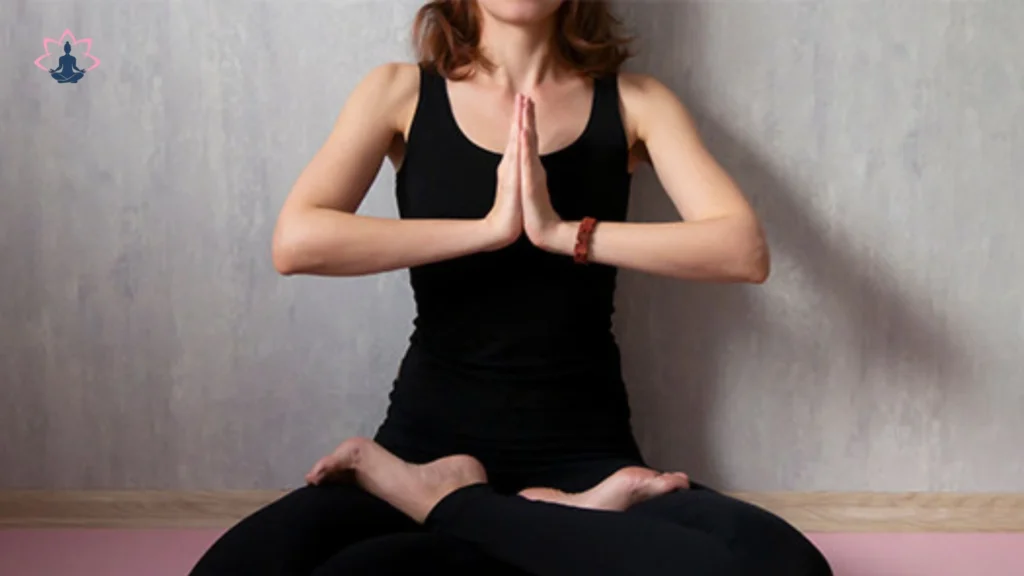
How to Practice Anjali Mudra
- Formation: Sit or stand comfortably with your back straight. Bring your palms together at the heart center, ensuring your fingers are aligned and your thumbs are close to your chest.
- Duration and Frequency: Practice Anjali Mudra during meditation, yoga sessions, or as a greeting. It can be done for a few minutes daily to cultivate mindfulness.
Benefits of Anjali Mudra
Physical Benefits:
- Flexibility: Enhances flexibility in the wrists and arm joints.
- Circulation: Improves blood circulation and oxygen flow, calming the nervous system.
- Endocrine Balance: Stimulates the thymus gland, supporting the endocrine system.
Mental and Emotional Benefits:
- Stress Relief: Reduces stress and anxiety by promoting relaxation and calmness.
- Focus and Concentration: Increases focus and concentration, ideal for meditation and pranayama practices.
- Emotional Balance: Encourages humility, gratitude, and self-awareness.
Spiritual Benefits:
- Chakra Activation: Balances and activates the Heart Chakra (Anahata) and Third Eye Chakra (Ajna), enhancing intuition and spiritual awareness.
- Unity and Connection: Fosters a sense of unity and connection with oneself and others, promoting inner peace and harmony.
Symbolism and Meaning
Anjali Mudra is a living example of “Namaste,” which translates as “I bow to you” or “The divine in me bows to the divine in you.” It represents reverence and acknowledgment of the divine within oneself and others, and unity beyond physical differences.
Additional Tips
- Complementary Practices: Combine Anjali Mudra with meditation or specific yoga poses like Mountain Pose (Tadasana) to enhance its benefits.
- Precautions: Generally safe, but consult a yoga expert if you have specific health concerns or questions about practicing this mudra.
See also: How to Meditation in 7 Simple Steps
6. Prana Mudra (Mudra of Life)
Prana Mudra, also known as the “life force seal,” is a significant hand gesture in yoga and meditation. It is believed to stimulate dormant energy within the body, revitalizing the spirit and instilling a sense of well-being. This mudra balances essential elements—earth, water, and fire—crucial for maintaining physical and emotional health.
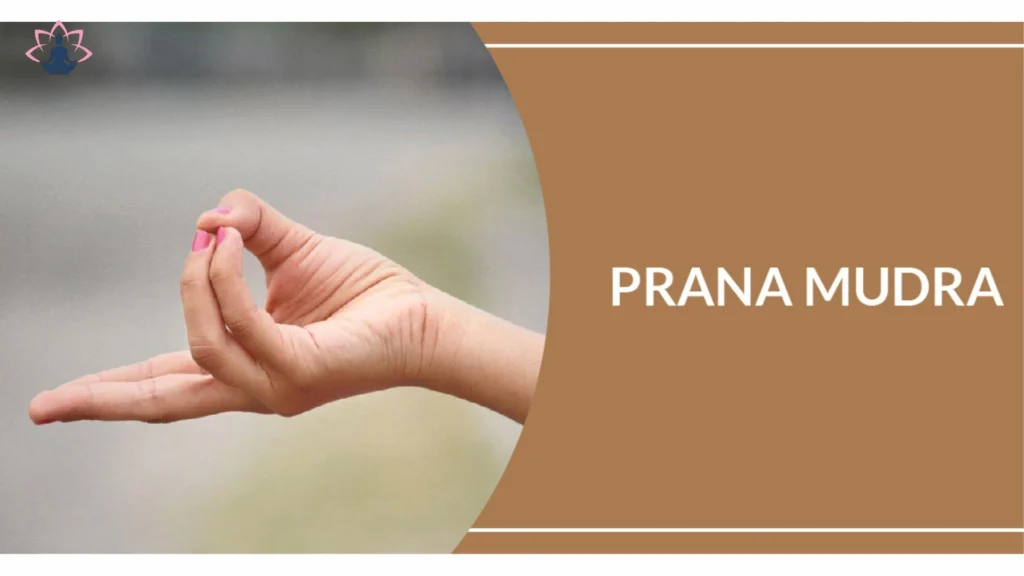
How to Practice Prana Mudra
- Formation: Sit comfortably. Touch the tips of the ring and little fingers to the tip of the thumb, keeping the index and middle fingers straight3.
- Duration and Frequency: Practice Prana Mudra for 15 to 30 minutes daily during meditation or relaxation.
Benefits of Prana Mudra
- Energy Boost: Prana Mudra encourages an energy boost in the body, reducing tiredness and laziness. It helps overcome chronic fatigue and exhaustion.
- Immunity: It strengthens the body’s defenses, enhancing immunity and increasing the capacity to fight diseases.
- Balances Elements: This mudra works by reducing the Pitta (Fire) element while increasing the Kapha (Water) element in the body.
- Calms the Mind: By helping control and reduce the Fire element, Prana Mudra reduces mental tensions, including anger, agitation, and restlessness. It promotes inner stability, faith, joy, zeal, and happiness.
- Arthritis: It increases Kapha energy, which helps keep joints lubricated, taking care of arthritis.
- Hypertension: Prana Mudra is said to keep blood pressure in control.
- Vision Improvement: Daily practice may offer solutions for eye-related issues such as dryness and redness and might even improve eyesight.
- Improved Circulation: Prana Mudra improves blood circulation throughout the body, ensuring essential nutrients reach all cells and tissues. Enhanced circulation may alleviate health issues and champion overall well-being.
- Pain Relief: Prana Mudra’s healing qualities may be able to lessen a number of pains, such as headaches, muscular aches, and joint pain.
- Respiratory Function: It potentially enhances respiratory function by controlling breathing techniques that help maintain healthy lungs.
Spiritual Benefits
Prana Mudra improves concentration, bringing a better meditation experience and spiritual awakening. Regular practice helps balance the body’s energy, reducing mental tension, anxiety, and negative feelings. It promotes self-confidence, mental clarity, and productivity.
Additional Tips
Remember to incorporate Prana Mudra into your daily routine consistently to lead a more balanced, energized, and healthier life. It can enhance general health when combined with other healthy lifestyle practices.
7. Apana Mudra (Downward-Flowing Energy Seal)
Apana Mudra is a powerful yoga gesture that balances the body’s downward-moving energy, essential for digestion, elimination, and reproductive functions. It is known for its ability to improve digestion, detoxify the body, and support emotional balance.
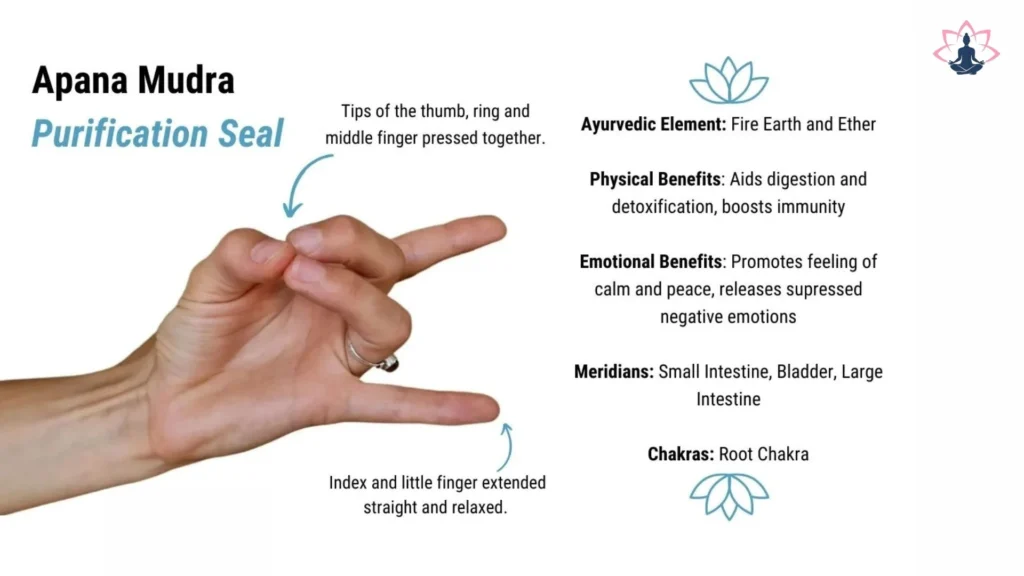
How to Practice Apana Mudra
- Formation: Touch the tips of the middle and ring fingers to the tip of the thumb. Keep the index and little fingers extended.
- Duration and Frequency: Practice Apana Mudra for 15 to 20 minutes daily, either in one session or divided into shorter periods.
Benefits of Apana Mudra
Physical Benefits:
- Digestion: Improves digestion by stimulating the downward energy flow, relieving constipation, bloating, and indigestion.
- Detoxification: Supports the body’s natural detoxification processes by promoting waste elimination and enhancing kidney function.
- Reproductive Health: Enhances reproductive health for both men and women, regulating menstrual cycles and alleviating menstrual cramps.
- Pain Relief: Relieves stomach pain, vomiting, hiccups, and restlessness.
- Skin Health: Enriches the skin, making it glow.
- Diabetes Management: Helps control diabetes when practiced consistently.
Mental and Emotional Benefits:
- Emotional Balance: Promotes mental clarity and emotional stability.
- Anxiety Reduction: Reduces anxiety and provides anchoring, helping with insomnia.
Spiritual Benefits:
- Energy Balance: Balances the body’s energy by stimulating the apana vayu, enhancing overall well-being.
Precautions
- Pregnancy: Avoid practicing Apana Mudra during the first eight months of pregnancy due to its strong downward force, which could lead to miscarriage. However, it can aid in smooth childbirth if practiced in the final month.
- Health Conditions: Individuals with diarrhea, dysentery, cholera, or colitis should avoid this mudra.
Additional Tips
- Complementary Practices: Combine Apana Mudra with meditation or deep breathing exercises to enhance its benefits.
- Consultation: Consult a healthcare professional before starting if you have specific health concerns.
8. Apana Vayu Mudra (Gesture of Downward Flowing Prana)
Apana Vayu Mudra is a powerful yoga gesture that combines the benefits of both Apana and Vayu Mudras. It is particularly renowned for its ability to support heart health and emotional balance.
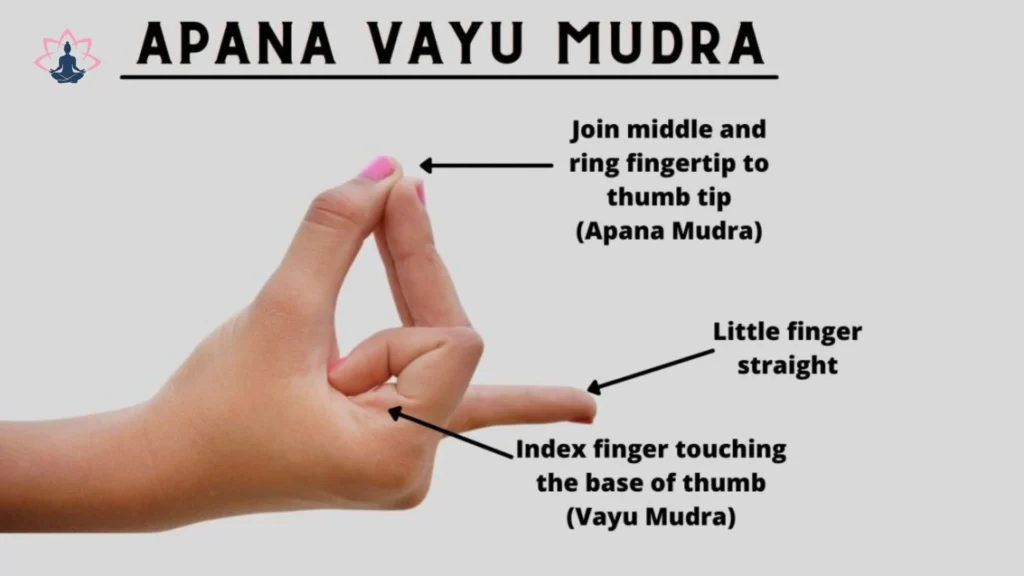
How to Practice Apana Vayu Mudra
- Formation: To form Apana Vayu Mudra, first create Vayu Mudra by placing the tip of the index finger at the base of the thumb. Then, form Apana Mudra by touching the tips of the middle and ring fingers to the thumb, keeping the index finger in place at the base of the thumb.
- Duration and Frequency: Practice this mudra for about 15 to 30 minutes daily, ideally during meditation or relaxation.
Benefits of Apana Vayu Mudra
Physical Benefits:
- Heart Health: Supports cardiovascular health by regulating circulation and calming the heart. It is believed to prevent heart attacks and reduce palpitations.
- Digestion: Improves digestive processes and helps with detoxification.
- Nervous System: Balances the nervous system, reducing nervousness and anxiety.
Mental and Emotional Benefits:
- Anxiety Reduction: Helps reduce mental tension, anxiety, and other negative emotions, promoting emotional stability.
- Emotional Balance: Grounds the practitioner, releasing fear and worry.
Spiritual Benefits:
- Prana Balance: Balances the flow of prana, creating stability and harmony within the body.
Additional Tips
- Complementary Practices: Combining Apana Vayu Mudra with specific yoga poses like Pawanmuktasana or Vajrasana can enhance its benefits.
- Precautions: While generally safe, consult a yoga expert if you have specific health concerns or questions about practicing this mudra.
9 . Varuna Mudra (Seal of Water)
Varuna Mudra, also known as Jala Mudra, is a powerful yoga gesture that enhances the body’s water element. It is beneficial for maintaining hydration, improving skin health, and promoting mental clarity.

How to Practice Varuna Mudra
- Formation: To practice Varuna Mudra, touch the tip of the little finger to the tip of the thumb. The remaining fingers should remain stretched and straight.
- Duration and Frequency: Practice Varuna Mudra for about 15 to 30 minutes daily, ideally during meditation or relaxation.
Benefits of Varuna Mudra
Physical Benefits:
- Hydration: Helps maintain proper hydration levels, preventing dehydration and related issues like fatigue and dry skin.
- Skin Health: Improves skin moisture, reducing dryness, itchiness, and conditions like eczema and psoriasis.
- Joint Health: Lubricates joints, reducing stiffness and improving mobility, which is beneficial for conditions like osteoarthritis.
- Eye Health: Keeps the eyes moist, preventing dryness and blurred vision.
- Digestion: Supports digestive health by maintaining adequate fluid levels, preventing constipation and bloating.
Mental and Emotional Benefits:
- Mental Clarity: Enhances mental clarity and concentration, promoting emotional balance.
- Emotional Purification: Purifies negative emotions and patterns, increasing confidence and communication skills.
- Stress Relief: Reduces stress and anxiety by promoting fluidity and adaptability in thought and action.
Spiritual Benefits:
- Chakra Balance: Stimulates the sacral chakra, enhancing creativity and emotional balance.
- Water Element Balance: Balances the water element in the body, which is crucial for overall health and well-being.
Symbolism and Meaning
Varuna Mudra symbolizes the water element, which represents fluidity, adaptability, and emotional balance. It helps connect with these qualities, promoting inner harmony and resilience.
Additional Tips
- Complementary Practices: Combine Varuna Mudra with meditation or specific yoga poses like Viparita Karani (Legs Up The Wall Pose) to enhance its benefits.
- Precautions: Avoid practicing Varuna Mudra if you have issues with water retention or severe colds and coughs, as it increases the water element in the body.
10. Dhyana Mudra (Meditation Seal)
Dhyana Mudra, also known as the Meditation Seal, is a revered hand gesture used in yoga and meditation practices. It is designed to deepen concentration, promote inner peace, and guide the practitioner toward spiritual growth.
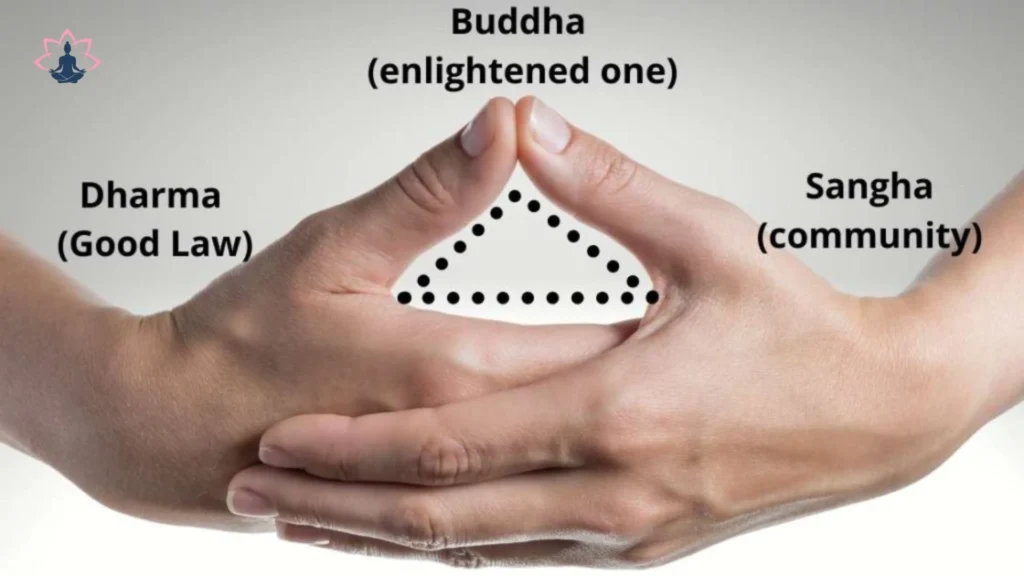
How to Practice Dhyana Mudra
- Formation: Sit comfortably in a meditative posture such as Sukhasana (Easy Pose) or Padmasana (Lotus Pose). Place your right hand over your left, with palms facing upwards. Allow your thumbs to touch lightly, forming a gentle connection.
- Duration and Frequency: Practice Dhyana Mudra for at least 30 minutes daily during meditation. It can be practiced at any time, but morning is ideal for enhancing concentration.
Benefits of Dhyana Mudra
Mental and Emotional Benefits:
- Concentration and Focus: Enhances concentration and focus, making it easier to meditate and stay on track.
- Stress Relief: Reduces stress and anxiety by calming the mind and promoting relaxation.
- Emotional Balance: Helps manage emotions, reducing irritability and negative thoughts.
- Memory and Confidence: Improves memory and boosts confidence by promoting mental clarity.
Physical Benefits:
- Relaxation: Relaxes the body, releasing tension and promoting overall well-being.
- Sleep Improvement: Enhances sleep quality by calming the mind and body.
- Headache Relief: May help alleviate headaches due to its calming effects.
Spiritual Benefits:
- Spiritual Growth: Facilitates spiritual growth by connecting the practitioner with their inner self and promoting a sense of unity.
- Inner Peace: Encourages inner peace and equanimity, helping the practitioner achieve deeper states of meditation.
Symbolism and Meaning
Dhyana Mudra symbolizes the union of opposites—wisdom and illusion, male and female principles—representing balance and harmony. It is often depicted in Buddhist art as a gesture of enlightenment, practiced by the Buddha during his meditation under the Bodhi tree.
Additional Tips
- Complementary Practices: Combine Dhyana Mudra with pranayama or visualization techniques to enhance its benefits.
- Precautions: Generally safe, but consult a yoga expert if you have specific health concerns or questions about practicing this mudra.
These mudras can be practiced during meditation or yoga sessions to enhance their benefits. Regular practice can lead to improved physical and mental well-being.
Conclusion
Yoga mudras are simple yet powerful tools that can enhance your yoga practice by balancing the body’s energy and promoting physical and mental well-being. Each mudra has specific benefits, ranging from improving concentration and creativity to aiding digestion and heart health. Incorporating these mudras into your daily routine can lead to a more balanced and harmonious life. Whether you’re seeking to enhance your meditation practice or improve your overall health, these ten yoga mudras offer a comprehensive approach to achieving wellness.
FAQ
How often should I practice yoga mudras?
How often should I practice yoga mudras?
The frequency of practicing yoga mudras depends on the specific mudra and its benefits. Generally, practicing them daily for a few minutes can be beneficial.
Can anyone practice yoga mudras?
Can anyone practice yoga mudras?
Yes, anyone can practice yoga mudras. They are simple and accessible, making them suitable for all ages and levels of yoga practice.
What are the benefits of practicing yoga mudras?
What are the benefits of practicing yoga mudras?
Practicing yoga mudras can enhance concentration, improve physical health, reduce stress, and promote spiritual growth.
Do yoga mudras have any side effects?
Do yoga mudras have any side effects?
Generally, yoga mudras are safe and do not have significant side effects when practiced correctly. However, it’s advisable to consult a yoga expert if you have specific health concerns.